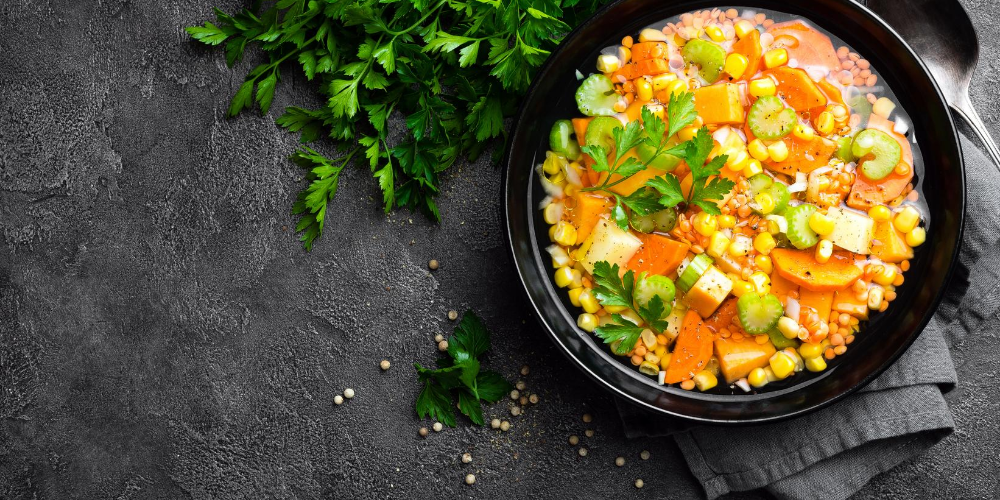Green vegetables contain a lot of vitamins, fiber, and minerals for the body, but most babies do not like to eat vegetables. So how do children like to eat vegetables? This is a problem because vegetables tends to taste less appealing than meat or processed foods. The following article will point out the causes and ways to build vegetable recipes for children.


1. The role of green vegetables in children’s development
The amazing benefits of fruits and vegetables have been scientifically proven to be extremely necessary for the health of adults as well as children in their daily meals. They play an important role in the development of both physical and mental health of children
- Fiber supply: Fiber is a source of nutrients for the intestinal microflora, which helps the digestive system stay healthy, while meat and dairy products are not available. The fiber in green vegetables is not broken down by the digestive system and it will allow waste to move easily through the digestive tract. This helps prevent constipation and inflammation of the digestive tract for children. Not only that, but a high-fiber diet also helps the baby’s cardiovascular system to develop, preventing cholesterol in the later stages.
- Prevent obesity: Green vegetables contain a large amount of water and fiber to keep them full for a long time without eating too many calories at mealtime and still full of nutrients. Vegetables that belong to food groups have a low energy density and thus help maintain healthy body weight. According to experts, children who eat a lot of vegetables often have lower body weight than other children. Christine Gerbstadt, a spokesman for the American Dietetic Association, said: “A diet rich in vegetables contains lower calories and fat, thus preventing early obesity in babies.”
- Water supply: Vegetables provide a huge amount of water for the young body in the development stage. Water-rich vegetables like carrots, lettuce, turnips, or broccoli contain up to 90% water.
- Help your body develop healthily: Vegetables contain many essential vitamins and minerals such as vitamins A, C, E, Potassium … help build cells, develop tissue, and maintain the activity of organs in a child’s body.
2. Why children don’t like vegetables ?
- Babies under 3 years of age usually prefer colorful colors, they hate green. Therefore, children under 3 who often do not like to eat vegetables are a common phenomenon.
- Another cause is also related to the development of teeth and the child’s chewing strength. Babies who do not like to eat foods that are too hard and difficult to swallow.
- In addition, picky children are also due to fast food and other foods such as meat, milk, fish … more and more flavorful, they appeal to children rather than vegetables.
- The changing environment in the family is also one of the major causes. Couples who often eat at restaurants with strange and expensive dishes, will of course lead to a picky phenomenon of children.
3. What are the solutions?
3.1 Use a variety of vegetables


✅ Children should eat a lot of vegetables with a variety of processing methods such as boiling, stir-frying, etc. to investigate your child’s taste. Maybe you will find out your child’s interest in a certain vegetable.
3.2 Vegetable recipes : Add spices, sauces


✅ Sometimes, you just need to sprinkle the melted cheese on broccoli or cauliflower or sprinkle a little cream sauce on the baked potato to lure your child to eat well. Children love to dot themselves, so try to encourage your baby to eat colorful vegetables dipped with favorite dipping sauce.
3.3 Vegetable recipes : Use pizza


✅ You should add any vegetables to your favorite pizza, be it sliced tomatoes, fresh mushrooms, onions, peas, bell peppers … In fact, a lot of kids are interested in “broccoli on pizza”. And if your baby likes cheese, you should take this opportunity to add more cheese along with vegetables.
3.4 Mix vegetable salad


✅ Children may be attracted to the flavor and color of salad dressings. To make your food more colorful and more nutritious, you should mix a few sliced carrots and some delicious, crispy sweet broccoli.
3.5 Vegetable soup


✅ Babies may complain of carrots or boiled corn but love vegetable soup. If it is true that your child is like that, then when cooking soup you should add fresh vegetables, or canned or frozen in.
3.6 Vegetable juices


✅ Tomato juice or vegetable juice is also considered to be a useful supplement, so it is advisable to use fresh vegetable juice if possible because it is taken directly as it still retains vitamins and minerals in the vegetables.
4. Recommended for you :
🎁 Top vegetable juice on Amazon


✅ V8 100% Vegetable Juice is made from a blend of eight different veggies. This uniquely satisfying combination was developed back in 1933 – well before juicing became a way of life.
✅ V8 100% Vegetable Juice doesn’t contain any added preservatives, flavors, or colors. It is also an excellent source of antioxidant vitamins A & C. For variety, it comes in Spicy Hot and Low Sodium versions, too.
✅ Keep some chilled in the fridge so you can get your veggies at any time. You can enjoy as is, customize it or use it as a mix for Bloody Marys and mocktails. On the go? Just keep easy-to-carry, single-serve cans on hand.






Leave a Reply